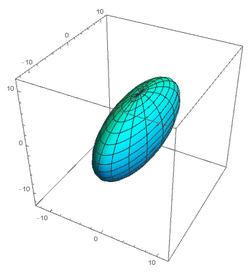Kasner metric
| General relativity |
|---|
 |

The Kasner metric (developed by and named for the American mathematician Edward Kasner in 1921)[2] is an exact solution to Albert Einstein's theory of general relativity. It describes an anisotropic universe without matter (i.e., it is a vacuum solution). It can be written in any spacetime dimension [math]\displaystyle{ D\gt 3 }[/math] and has strong connections with the study of gravitational chaos.
Metric and conditions
The metric in [math]\displaystyle{ D\gt 3 }[/math] spacetime dimensions is
- [math]\displaystyle{ \text{d}s^2 = -\text{d}t^2 + \sum_{j=1}^{D-1} t^{2p_j} [\text{d}x^j]^2 }[/math],
and contains [math]\displaystyle{ D-1 }[/math] constants [math]\displaystyle{ p_j }[/math], called the Kasner exponents. The metric describes a spacetime whose equal-time slices are spatially flat, however space is expanding or contracting at different rates in different directions, depending on the values of the [math]\displaystyle{ p_j }[/math]. Test particles in this metric whose comoving coordinate differs by [math]\displaystyle{ \Delta x^j }[/math] are separated by a physical distance [math]\displaystyle{ t^{p_j}\Delta x^j }[/math].
The Kasner metric is an exact solution to Einstein's equations in vacuum when the Kasner exponents satisfy the following Kasner conditions,
- [math]\displaystyle{ \sum_{j=1}^{D-1} p_j = 1, }[/math]
- [math]\displaystyle{ \sum_{j=1}^{D-1} p_j^2 = 1. }[/math]
The first condition defines a plane, the Kasner plane, and the second describes a sphere, the Kasner sphere. The solutions (choices of [math]\displaystyle{ p_j }[/math]) satisfying the two conditions therefore lie on the sphere where the two intersect (sometimes confusingly also called the Kasner sphere). In [math]\displaystyle{ D }[/math] spacetime dimensions, the space of solutions therefore lie on a [math]\displaystyle{ D-3 }[/math] dimensional sphere [math]\displaystyle{ S^{D-3} }[/math].
Features
There are several noticeable and unusual features of the Kasner solution:
- The volume of the spatial slices is always [math]\displaystyle{ O(t) }[/math]. This is because their volume is proportional to [math]\displaystyle{ \sqrt{-g} }[/math], and
- [math]\displaystyle{ \sqrt{-g} = t^{p_1 + p_2 + \cdots + p_{D-1}} = t }[/math]
- where we have used the first Kasner condition. Therefore [math]\displaystyle{ t\to 0 }[/math] can describe either a Big Bang or a Big Crunch, depending on the sense of [math]\displaystyle{ t }[/math]
- Isotropic expansion or contraction of space is not allowed. If the spatial slices were expanding isotropically, then all of the Kasner exponents must be equal, and therefore [math]\displaystyle{ p_j = 1/(D-1) }[/math] to satisfy the first Kasner condition. But then the second Kasner condition cannot be satisfied, for
- [math]\displaystyle{ \sum_{j=1}^{D-1} p_j^2 = \frac{1}{D-1} \ne 1. }[/math]
- The Friedmann–Lemaître–Robertson–Walker metric employed in cosmology, by contrast, is able to expand or contract isotropically because of the presence of matter.
- With a little more work, one can show that at least one Kasner exponent is always negative (unless we are at one of the solutions with a single [math]\displaystyle{ p_j=1 }[/math], and the rest vanishing). Suppose we take the time coordinate [math]\displaystyle{ t }[/math] to increase from zero. Then this implies that while the volume of space is increasing like [math]\displaystyle{ t }[/math], at least one direction (corresponding to the negative Kasner exponent) is actually contracting.
- The Kasner metric is a solution to the vacuum Einstein equations, and so the Ricci tensor always vanishes for any choice of exponents satisfying the Kasner conditions. The full Riemann tensor vanishes only when a single [math]\displaystyle{ p_j=1 }[/math] and the rest vanish, in which case the space is flat. The Minkowski metric can be recovered via the coordinate transformation [math]\displaystyle{ t' = t \cosh x_j }[/math] and [math]\displaystyle{ x_j' = t \sinh x_j }[/math].
See also
Notes
References
- Misner, Charles W.; Kip S. Thorne; John Archibald Wheeler (September 1973). Gravitation. San Francisco: W. H. Freeman. ISBN 0-7167-0344-0.
 |


